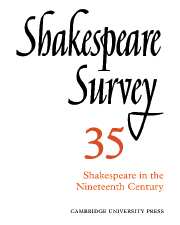Book contents
- Frontmatter
- Before the Shakespeare Revolution: Developments in the Study of Nineteenth-Century Shakespearian Production
- The Meininger Company and English Shakespeare
- Shakespeare at the Burgtheater: From Heinrich Anschütz to Josef Kainz
- Shakespeare on the Melbourne Stage, 1843-61
- Shakespeare in Hazlitt’s Theatre Criticism
- Characterization of the Four Young Lovers in A Midsummer Night’s Dream
- Queenly Shadows: On Mediation in Two Comedies
- Language, Theme, and Character in Twelfth Night
- The Art of the Comic Duologue in Three Plays by Shakespeare
- ‘Spanish’ Othello: The Making of Shakespeare’s Moor
- Ferdinand and Miranda at Chess
- Shakespeare’s Latin Citations: The Editorial Problem
- The Theatre at Christ Church, Oxford, in 1605
- Interpretations of Shakespearian Comedy, 1981
- The Year's Contributions to Shakespearian Study 1 Critical Studies
- 2 Shakespeare’s Life, Times and Stage
- 3 Textual Studies
- Index
- Plate Section
2 - Shakespeare’s Life, Times and Stage
Published online by Cambridge University Press: 28 March 2007
- Frontmatter
- Before the Shakespeare Revolution: Developments in the Study of Nineteenth-Century Shakespearian Production
- The Meininger Company and English Shakespeare
- Shakespeare at the Burgtheater: From Heinrich Anschütz to Josef Kainz
- Shakespeare on the Melbourne Stage, 1843-61
- Shakespeare in Hazlitt’s Theatre Criticism
- Characterization of the Four Young Lovers in A Midsummer Night’s Dream
- Queenly Shadows: On Mediation in Two Comedies
- Language, Theme, and Character in Twelfth Night
- The Art of the Comic Duologue in Three Plays by Shakespeare
- ‘Spanish’ Othello: The Making of Shakespeare’s Moor
- Ferdinand and Miranda at Chess
- Shakespeare’s Latin Citations: The Editorial Problem
- The Theatre at Christ Church, Oxford, in 1605
- Interpretations of Shakespearian Comedy, 1981
- The Year's Contributions to Shakespearian Study 1 Critical Studies
- 2 Shakespeare’s Life, Times and Stage
- 3 Textual Studies
- Index
- Plate Section
Summary
I have already publicly expressed my view that John Padel’s study will entirely alter our understanding of the sonnets, not only in terms of their immediate historical background, but also of their nature as literary artefacts. I did so after a careful perusal of the original manuscript about two years ago. An equally careful reading of the printed version (slightly modified from the original) leaves my conviction not only unshaken but if anything strengthened. Briefly, Padel contends that Shakespeare devised a new form using the fourteen-line sonnet, a four-sonnet grouping of which he wrote thirty-one for the young William Herbert, together with seven three-sonnet sequences about the Dark Lady. This involves skilful navigation in that perilous sea, the reordering of the sequence, and the book is in fact subtitled ‘Order and meaning restored to the Sonnets’. It is pointless and unnecessary to attempt a summary of the carefully worked-out argument with which the author supports his view. The evidence is of three kinds, historical (mainly relating to the Herbert family), literary-critical, and psychological (Padel was until recently a senior member of the Tavistock Clinic). None of it is without importance in detail and cumulatively it is very impressive indeed. Even those who remain unconvinced after considering it will be refreshed by their encounter with a disciplined intelligence and a sensibility which is truly responsive to the sonnets as poetry.
- Type
- Chapter
- Information
- Shakespeare Survey , pp. 174 - 179Publisher: Cambridge University PressPrint publication year: 1982



